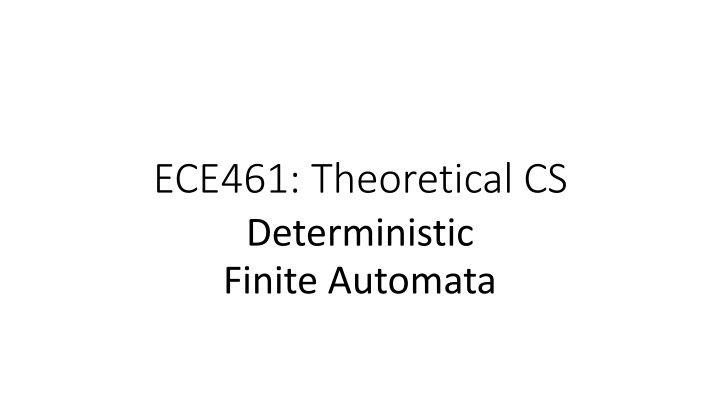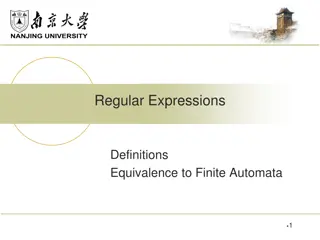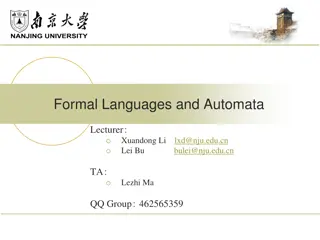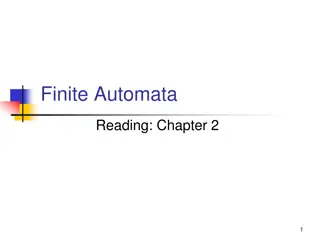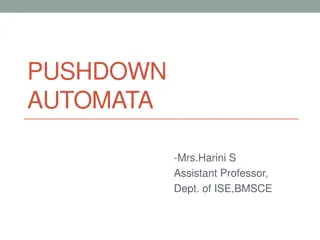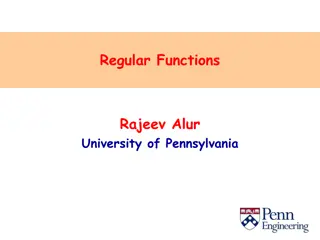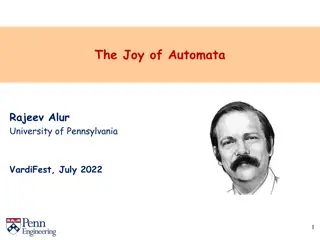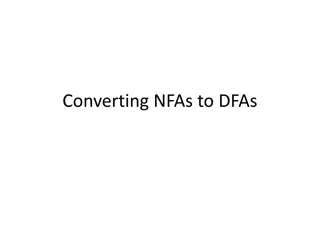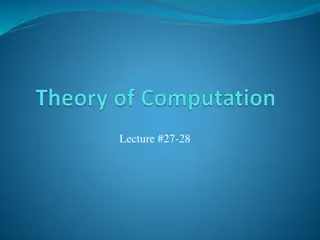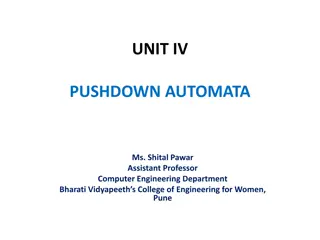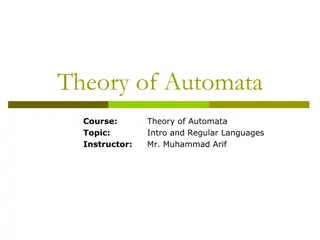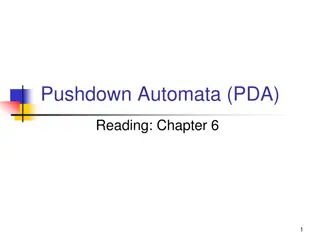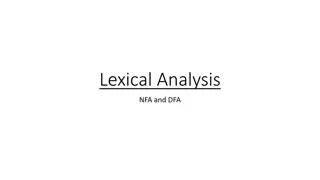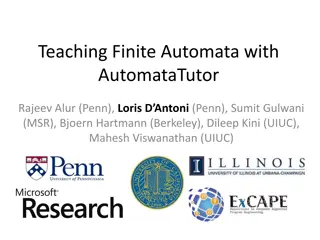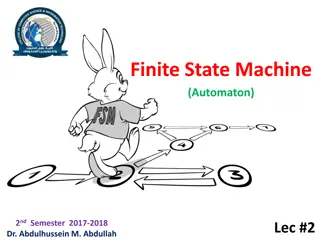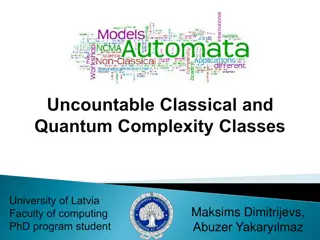Theoretical Computer Science: Deterministic Finite Automata
In the beginning of the course, we delve into computational models starting with deterministic finite automata (DFA). Explore the history of automata theory and the significance of DFAs in computing. Witness the foundation of automata theory laid by pioneers such as Kleene, McCulloch, and Pitts.
Download Presentation

Please find below an Image/Link to download the presentation.
The content on the website is provided AS IS for your information and personal use only. It may not be sold, licensed, or shared on other websites without obtaining consent from the author.If you encounter any issues during the download, it is possible that the publisher has removed the file from their server.
You are allowed to download the files provided on this website for personal or commercial use, subject to the condition that they are used lawfully. All files are the property of their respective owners.
The content on the website is provided AS IS for your information and personal use only. It may not be sold, licensed, or shared on other websites without obtaining consent from the author.
E N D
Presentation Transcript
ECE461: Theoretical CS Deterministic Finite Automata
Finite Automata In the first portion of this course, we will introduce various computational models The first sort of model we will consider is called a finite automaton, a.k.a. a finite state machine; the plural is finite automata This topic is based on Section 1.1 of the textbook We will ultimately see two variations of finite automata We will start with a deterministic version of the model, so we can refer to this as a deterministic finite automaton (DFA) Note that the textbook does not introduce the term DFA until they introduce nondeterminism, later in the chapter Book: "Finite automata are good models for computers with an extremely limited amount of memory" We will see (and prove), however, that the model cannot recognize all languages Despite their limitations, DFAs (and equivalent models) are useful for certain applications In later topics, we will see more powerful models of computation
Brief Early History of Automata Theory The concept of Turing machines was introduced by Alan Turing in a seminal 1936 paper Later in the course, we will learn that Turing machines are as powerful as any known formalism, and the definition of an algorithm is based on this However, Turing machines assume the existence of infinite memory; they are not physically realizable One of the earliest works often cited in histories of automata theory is a paper by McCulloch and Pitts in 1943 They proposed a model for an artificial neuron, to simulate neurons from the human brain Nodes in modern neural networks still have a strong resemblance to their model This work is often discussed in histories of AI and machine learning The concepts of finite automata (the deterministic version) and regular expressions were both introduced in a paper by Kleene in 1951 This paper introduced both models and also proved their equivalence According to some sources, Kleene was influenced by McCulloch and Pitts, and was interested in exploring models of computation that were potentially physically realizable, i.e., that used only finite memory The nondeterministic finite automaton was introduced in a 1959 paper by Rabin and Scott The paper, in general, explored variations of finite automata, as well as the limitations of such models The same paper proved the equivalence of deterministic and nondeterministic finite automata We will learn about nondeterministic finite automata and regular expressions in our next two topics
DFA Example The figure below, from the textbook, shows a state diagram for a particular DFA that we will call M1: Components of the DFA indicated in the state diagram include: The circles represent the set of states that the machine might be in Double circles represent accept states (a.k.a. final states); the accept states are a subset of the states The arrow without a source points to the start state (a.k.a. initial state), which is a member of the set of states The arrows represent transitions, labeled with symbols from the machines alphabet After processing a sequence of input, the machine accepts or rejects the input, depending on whether or not it ends at an accept state
Formal Definition of a DFA We will now consider a formal definition of a deterministic finite automaton (Definition 1.5 from the textbook) A finite automaton is a 5-tuple (Q, , , q0, F), where: 1. Q is a finite set called the states, 2. is a finite set called the alphabet, 3. : Q Q is the transition function, 4. q0 Q is the start state, and 5. F Q is the set of accept states The textbook points out that certain questions about deterministic finite automata can be answered by looking at the formal definition; e.g.: It is allowable for a DFA to have no accept states There must be exactly one transition from each state for each alphabet symbol Note that the textbook still refers to DFA as finite automata, more generally, up tot his point, but this definition specifically applies to deterministic finite automata
Formal Description of a DFA Example We can now describe M1, seen earlier as a state diagram, formally M1= (Q, , , q1, F), where: 1. Q = {q1, q2, q3}, 2. = {0, 1}, 3. can described as: 4. q1is the start state, and 5. F = {q2}
Languages As we learned in our introductory topic, a language is a set of strings Every DFA recognizes, or accepts, a language If A is the language recognized by a machine, M, we can say: A is the language of machine M L(M) = A M recognizes A M accepts A The book points out that "accepts" can be used for languages or for individual strings, so they prefer to use "recognizes" for languages (I personally tend to use both terms for languages) Note that even if a machine accepts no strings, it still recognizes a language This would be the empty language, which can be denoted as (the null sign) This is the same symbol used to represent the empty set, more generally Keep in mind that the empty language is different from the empty string, which can be denoted as We can describe the language of M1, from our previously example, as follows: L(M1) = A = {w | w contains at least one 1 and an even number of 0s follow the last 1}
Computation with a DFA Consider some DFA, M = (Q, , , q0, F) Also consider a string w = w1w2 wn, where each wiis a member of M's alphabet, Now consider applying w as the input to M (i.e., M will process the string w, one symbol at a time) We can say that M accepts w if and only if there exists a sequence of states r0, r1, , rn (all members of Q) such that the following three conditions hold: 1. r0= q0 2. (ri, wi+1) = ri+1for i = 0, 1, , n-1 3. rn F This should match our intuitive understanding of how a DFA processes its input The first condition states that we must start at the start state The second condition explains that we process one symbol at a time (the next input symbol) and deterministically proceed to the appropriate state, as specified by the transition function The third symbol says that the machine accepts the input if we end up at an accept state (although not mentioned here, we can say that otherwise the machine rejects the input)
Regular Languages A language is a regular language if and only if some DFA recognizes it This can serve as a definition of a regular language (it is Definition 1.16 in the textbook) In our next two topics, we will see other, equivalent definitions of regular languages In the topic after those, we will also prove that certain languages are not regular The textbook contains a subsection titled "Designing Finite Automata" with some helpful advice, and it steps through a couple of examples Of course, this will only be possible if the language is regular, which isn't always obvious one way or the other
Regular Operations We are defining three regular operations that can be applied to languages A and B (all part of Definition 1.23 in the textbook): Union: A B = {x | x A or x B} Concatenation: A B = {xy | x A and y B} Star (a.k.a. Kleene star): A*= {x1x2 xk| k 0 and each xi A} Note that union and concatenation are binary operations, while star is a unary operation I add: These definitions apply to languages in general, not just regular languages As far as I can tell, there is no great reason (other than historical) that these three operations are the only so-called regular operations For example, I have not found a logical reason that union is considered a regular operation, but intersection is not When we cover regular expressions, we will see that union is built into the formalism, and intersection is not (and I think that is why these are called regular operations, historically)
Regular Operations Example Consider the languages A = {good, bad} and B = {boy, girl} The book says that the alphabet for each language is = {a, b, .., z}, which is valid, but it could be a smaller subset of that We then have: A B = {good, bad, boy, girl} A B = {goodboy, goodgirl, badboy, badgirl} A*= { , good, bad, goodgood, goodbad, badgood, badbad, goodgoodgood, goodgoodbad, goodbadgood, goodbadbad, boodgoodgood, }
Closure A class of languages is closed under an operation if and only if applying the operation to two members of the class is guaranteed to result in another member of the class We will (eventually) show that the class of regular languages is closed under union, concatenation, and star We will start with proving closure under union (Theorem 1.25 in the textbook) Assume that A1and A2are regular languages; we want to prove that A1 A2is also regular IMO, this is the first interesting proof in the textbook; note that the textbook often starts with what they refer to as the "proof idea", and then proceed with the more technical "proof" In this case, the proof idea can be summarized as follows: By the definition of regular languages, we know that there are DFAs that recognize each regular language Let M1be a DFA that recognizes A1, and M2be a DFA that recognizes A2; we need to prove that there is also a DFA, M, that recognizes A1 A2 It may seem intuitive to have M simulate M1, and if that doesn't work, it could simulate M2, but this approach doesn't work, because we cannot unwind the input tape Instead, M must effectively simulate both M1and M2simultaneously, or in parallel We can achieve this by creating a machine, M, such that each state of M represents a pair of states from the original machines; the first part of each pair represents a state from M1, and the second part of each pair represents a state from M2 The accept states of M are the states that represent an accept state from M1or an accept state from M2
Proof of Closure Under Union Let M1= (Q1, , 1, q1, F1) be a DFA that recognizes regular language A1and M2= (Q2, , 2, q2, F2) be a DFA that recognizes regular language A2 We can construct M = (Q, , , q0, F) to recognize A1 A2as follows: Q = {(r1, r2) | r1 Q1and r2 Q2} = Q1 Q2 This is the Cartesian product of sets Q1and Q2 The number of elements in Q is |Q| = |Q1| * |Q2| (although this notation is not in the book) We are assuming that the alphabets of M, M1, and M2are identical; however, the proof can easily be extended to account for different alphabets For each (r1, r2) Q and a , we define: ((r1, r2), a) = ( 1(r1, a), 2(r2, a)) In other words, machine M is simulating what happens in both of the original machines at each step q0= (q1, q2) F = {(r1, r2) | r1 F1or r2 F2} = (F1 Q2) (Q1 F2) Interestingly, if we change the definition of F to be F = F1 F2, we obtain a proof that the class of regular languages is closed under intersection
Closure Under Concatenation/Star (for now) We could try a similar approach to prove closure under concatenation We could start by assuming the existence of two DFAs that recognize two languages, A1and A2 We could then try to construct a DFA that recognizes A1 A2 Similarly, we could try a similar approach to prove closure under star We could start by assuming the existence of a DFA that recognizes a language, A We could then try to construct a DFA that recognizes A* It turns out these proofs would be much more difficult for concatenation or star than for union Instead, we will put off these proofs until after we have discussed nondeterminism, as part of our next topic
